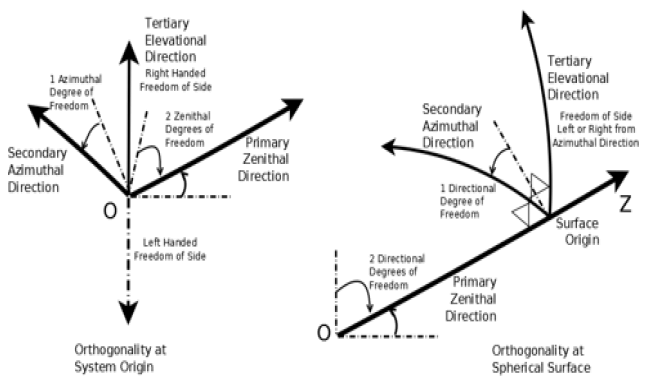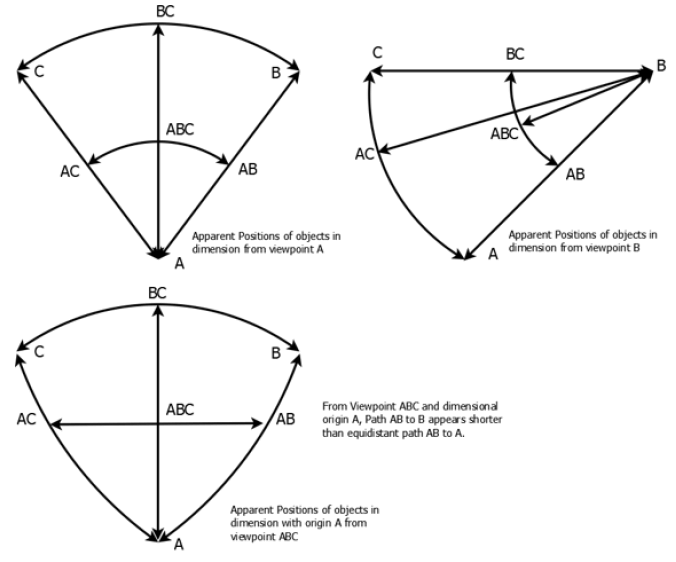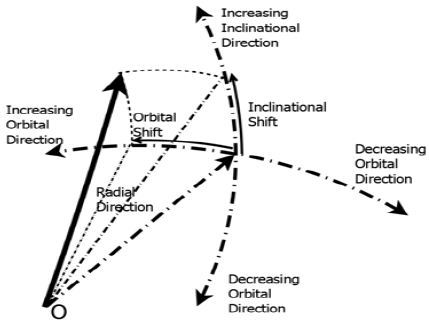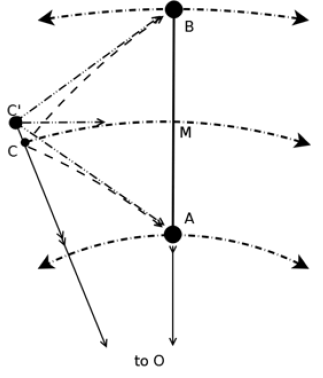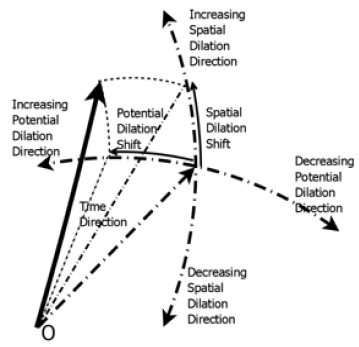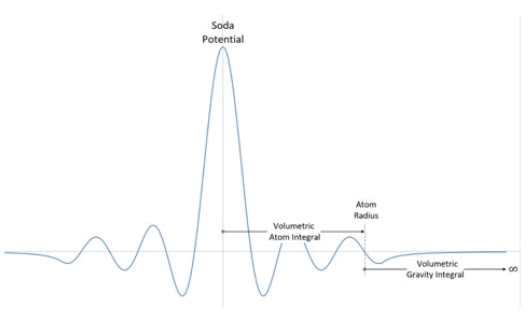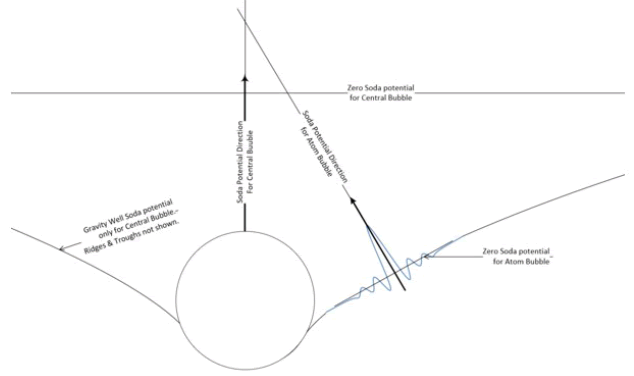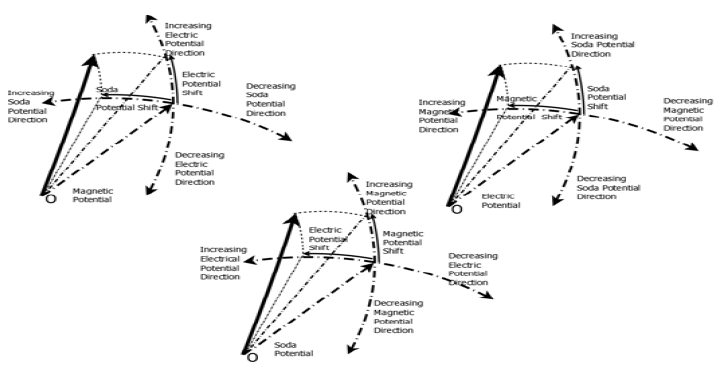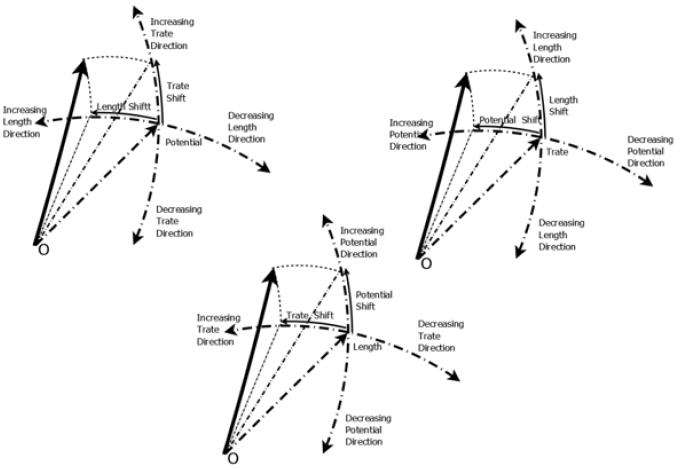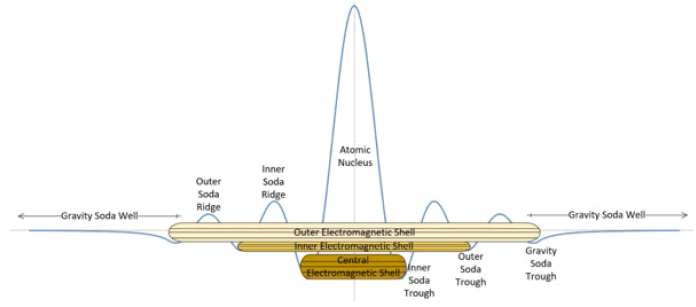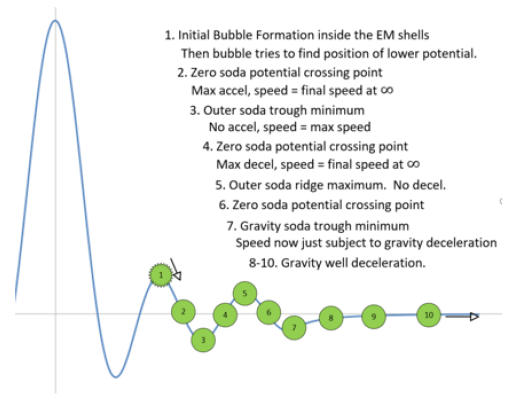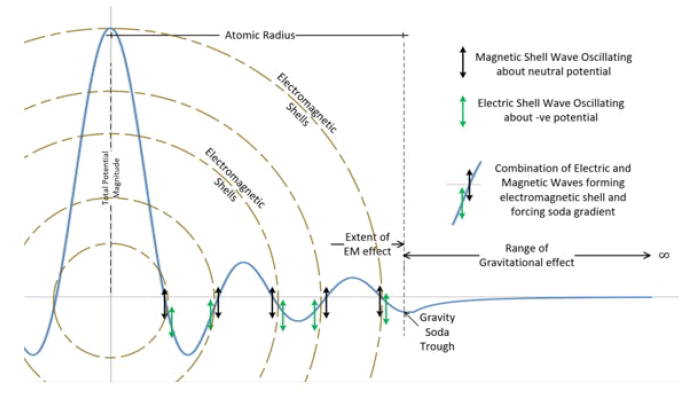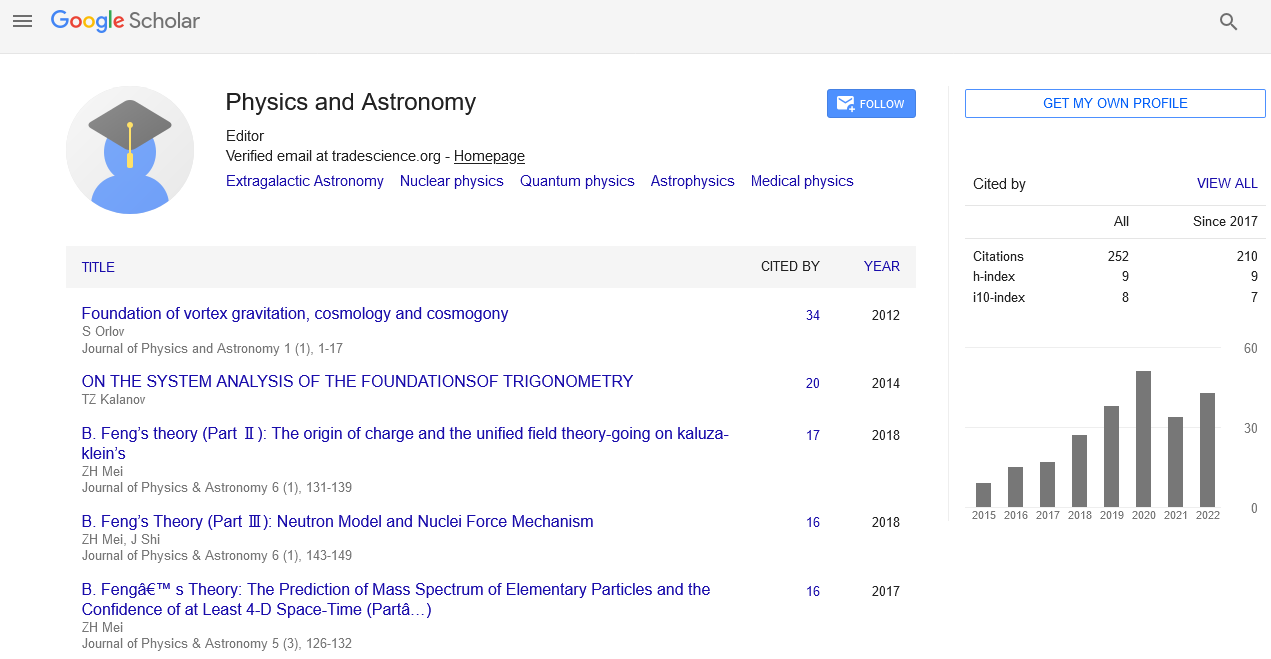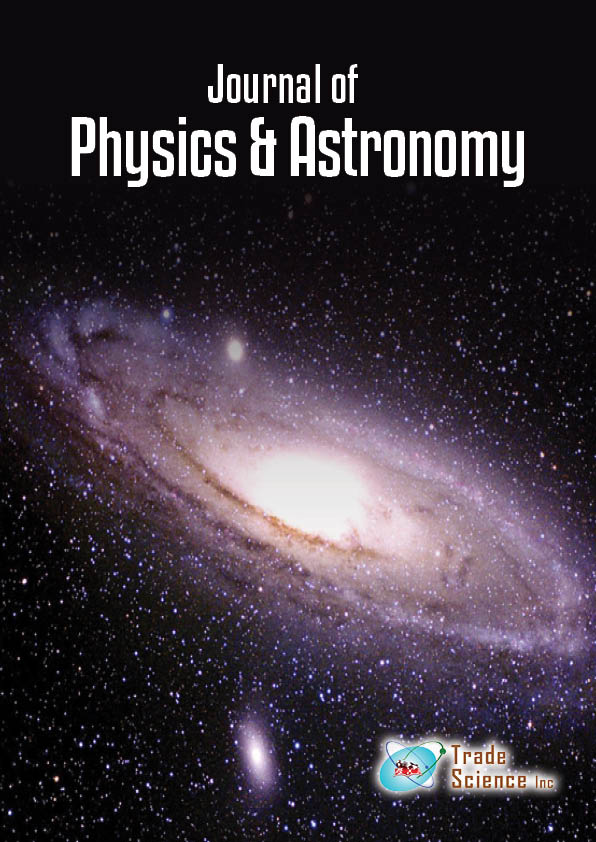Research
, Volume: 12( 10)A Universal Physics Model based on Spherical Dimensions
- *Correspondence:
- Andrew Bradford
Independent Researcher, Department of Cybernetics, Reading University, UK
E-mail: Andrew.Bradford@bradfords.me.uk
Received date: Oct-01-2024, Manuscript No. TSPA-24-100914; Editor assigned: Oct-05-2024, Pre-QC No. TSPA-24-100914(PQ); Reviewed: Oct-19-2024, QC No. TSPA-24-100914(Q); Revised: Oct-21-2024, Manuscript No. TSPA-24-100914(R); Published: Oct-27-2024, DOI. 10.37532/2320-6756.2024.12(10).226
Citation: Andrew Bradford, A Universal Physics Model based on Spherical Dimensions. J Phys Astron.2021;12(10):226.
Abstract
In recent decades, physics has produced some interesting conclusions on the nature of our universe such as the expansion of space and singularities within black holes. There are equally fantastic conclusions of the nature of quantum particles and effects. Yet we also hear that physics cannot unify these theories and there are still many things which do not make sense or things which these theories predict which have not been found. Applying an engineering problem solving technique, one looks for common assumptions which might have been made but are incorrect. The common assumption which came to mind was Dimensions. All of physics assumes that the dimensions of Mass, Length and Time are unidirectional and linear. Physics performs mathematical extrapolations and dimensional analysis with an unquestioned assumption of the linearity and the fundamentality of ML3T. In addition, there appears to be an overriding assumption of the pre-existence of particles within larger particles.
This paper proposes a radically different, yet readily understandable, alternative dimensional model. The model redefines those fundamental dimensions, repositioning an understanding of time and gravity, provides an alternative to the assumption of the preexistence of particles and proposes an elegant spherically dimensioned universal fabric from which everything in the universe can be constructed. The model presents a single basic physics dimensional framework on which all disciplines of physics could be reconfirmed or rebuilt.
Physics appears to be attempting to resolve astronomical physics with gravity as the only field forming galaxies, stars, planets and moons while it tries to resolve atomic and quantum physics with an assumption of the pre-existence of particles plus electrical and magnetic fields to explain atomic and quantum effects. This unified physics model proposes that gravity, electric and magnetic fields are exactly the same entity, but in different dimensional directions. This combination of 3 directions of similar fields forms a fabric which constructs and transmits everything we observe in the universe.
Keywords
Fundamental dimension; Spherical Dimensional; Quantum particles
Introduction
Black hole theory has come to conclusions, some of which include infinities or singularities. Astro-physics has concluded “space is expanding” a distance of 1 metre now is not the same as a distance of 1 metre in the past or in the future. Physics has concluded accretion disc theory explains the formation of galaxies, stars, planets and moons. Yet there are many observations which this does not well explain. Why are galaxies spiral? How have galaxies managed to accrete in to discs in only tens of galactic revolutions? How does Saturn keep its rings so perfectly circular and flat?
With persistent engineering problems one must take steps back from a problem to view it in its entirety. Without a view of the whole system, it is too easy to get so focused on details of an issue that one starts trying to fix the symptoms rather than searching for the root cause of the problem. This is increasingly the case as the size of the system increases. There are surely no systems larger than the universal physics model. With physicists specialising in their own discipline of the science, it must be easy to forget the possibility of inconsistencies with the absolute fundamentals, especially when those fundamentals have been accepted and taught as fact for hundreds, if not thousands of years.
Consideration of the question “What basic assumptions has physics made?” while developing this model led to an identification of 3 basic assumptions which physics seems to have made which this model challenges [1-3].
The first is the linearity of time. All of physics throughout history has assumed that time is linear and proceeds in a single direction. While it is recognised that science does not fully understand time, it is nevertheless treated in most physics equations as a uni-directional linear dimension. Time dilation and relativity theory hints that time is more complex than assumed yet mathematical extrapolations of physics theories continue on the assumption of this linearity.
The second assumption, extending from the first, is all of the fundamental dimensions used in dimensional analysis. Physics has assumed that all mechanics can be broken down to dimensions of ML3T a single linear dimension of Mass, 3 perpendicular linear dimensions of Length and a single linear dimension of Time. It has always seemed inelegant that there are different numbers of directions for these dimensions. One expects that the natural universe should be dimensionally more elegant than 1-3-1. Then, while Space and Time seem to define substantive substances, Mass would seem to be just a property of matter. Surely the fundamental dimensions should all be similarly substantive [4]?
The third assumption is the permanence of matter. An assumption of the pre-existence of particles coming from a larger particle when split appears debatable. When we get down to individual atoms physics has decided that an atom is made up of neutrons, protons and electrons and we know this because when an atom is broken up, that is what we see emitted [5]. This theory proposes that an atom is a bubble. If that bubble is suitably disturbed then it splits up forming new smaller bubbles with specific and predictable characteristics of neutrons, protons and electrons. Similarly, all of the quantum particles discovered are only being formed when their parent bubble is split.
This model has been arrived at by starting again. By looking at the universal system and redesigning dimensional fundamentals. By proposing a universal fabric constructed in, of and from those dimensions. By then re-evaluating how our universe might be formed and observed from such a hypothetical basis, could it be possible to create a radically different fundamental universal model, yet one which could still fit and explain what we observe? This paper presents such a fundamental model.
The Spherical Dimensional Universal Model
The Spherical Dimensional Universal Model is based on the following 8 principles:
1. All fundamental dimensions are spherical and dimensionally similar
2. There are 3 fundamental tangible and substantive spherical dimensions: spatial, temporal and physical
3. The Spatial dimension has magnitude of length with radial, orbital and inclinational orthogonal directions
4. The Temporal dimension has magnitude of trate with time, potential dilation and spatial dilation orthogonal directions
5. The Physical dimension has magnitude of potential with soda, electrical and magnetic orthogonal directions
6. A Universal dimension has magnitude with spatial, temporal and physical orthogonal directions
7. There is a continuous universal fabric consisting of all dimensions and directions within the Universal Dimension
8. Everything in the universe can be explained as patterns, waves or bubbles of this universal fabric
Spherical Dimensions
All fundamental dimensions are spherical and dimensionally similar
Fundamental Principle 1 defines that all fundamental dimensions are similarly spherical.
Dimensions have traditionally been assumed to be linear, continuous and unidirectional. The volumetric dimension of space has been assumed as 3 separate, perpendicular with linear dimensions of length with 3 equivalent magnitudes each in its own perpendicular direction x, y and z in a traditional Cartesian co-ordinate system. The Cartesian dimensional co-ordinate system provides that each linear dimension is perpendicular to another at all points. Being unidirectional, each linear dimension is considered straight. This does not allow for a system origin to be anything more than an arbitrary point of reference. With Cartesian co-ordinate systems, natural orbital paths, bubbles or spherical fields present as complex, dynamic and multi variable functions.
Spherical dimensions provide an origin at the centre of the system dimension relative to the origin of the object or direction being considered. Other dimensional directions are then orthogonal at all points relative to the origin.
Most importantly one can move (i.e. change magnitude) in any dimensional direction independently of the 2 other dimensional direction magnitudes. A change in magnitude in one direction becomes a change in direction, without change in magnitude, of the others. The dimensional directions are:- the primary zenithal direction which defines a surface radius, the secondary and tertiary direction magnitudes determine rates of change of direction of the zenithal magnitude.
A spherical dimensional quantity has a magnitude and this magnitude can never be negative. While there is an expectation that relative magnitudes could be negative, the sign of a relative magnitude actually just represents its direction or its side of freedom.
The zenithal direction is defined by being directly away from the spherical origin but this direction has 2 degrees of freedom. The second azimuthal direction has to be orthogonal to the radial direction but can be oriented in any direction with 1 degree of freedom. The third elevational direction has to be orthogonal to both the radial direction and the azimuthal direction. This means that the third direction only has a side of freedom to remain orthogonal to the other 2 directions FIG. 1.
With a spherical dimension, paths between 2 points are only straight to an observer on that path or on an extension of it. From this it follows that straightness is relative to the observer. To that observer for that measurement, they are the origin. Straightness can only be determined by verifying the points which are in line. That straightness will only agree for observers on that line.
With spherical dimensions it would be impossible to have 2 parallel straight lines as straight lines are always zenithal. While a flat plane in a spherical dimension is possible as a section through the spherical origin where one of the 2 zenithal degrees of freedom is defined or fixed, it is not possible to have 2 parallel flat planes.
FIG.2. shows that the curved path from A’s viewpoint of B to BC to C is a straight path from B’s viewpoint. That apparent curvature is dependent on the observers position within the dimension.
Fundamental Dimensions
There are 3 fundamental tangible and substantive spherical dimensions: spatial, temporal and physical
The number of fundamental spherical dimensions appears to be the minimum needed to be able to define the universe in its totality. They were developed from the 3 linear dimensions currently used in dimensional analysis of MLT, Mass, Length and Time, and which have been translated to Physical, Spatial and Temporal dimensions. In addition, these provide the 3 directions which define the universal dimension FIG.2 shows that the curved path from A’s viewpoint of B to BC to C is a straight path from B’s viewpoint V.
The spatial dimension: A single spherical spatial dimension is similar in concept to the volumetric, 3 perpendicular directions of a linear dimension of length, L, currently recognised. This makes the spatial dimension the easiest dimension to visualise and contemplate as it is totally formed from distance and directions and hence the most easily understood.
The temporal dimension: Fundamental principle 1 of this model requires the Temporal Dimension to be spherical and with similar dimensional properties to the Spatial Dimension. As time, the temporal dimension has always been considered to be a single linear dimension. This single linear temporal dimension is a fundamental assumption forming the foundation of all physics since the ancient Greeks. This theory proposes a radically different temporal dimension and consequential understanding of time.
The physical dimension: Fundamental principle 1 of this model requires the Physical Dimension to be spherical and with similar dimensional properties to the Temporal and Spatial Dimensions. It also needs to constitute a tangible substance which is quantifiable and has the directional properties of a spherical dimension. Mass is the traditional physical dimension used in physics dimensional analysis which again is considered as a single linear dimension. This is another fundamental axiom which forms the basis of physics without question. While the traditional dimensions of length and time relate to something substantively tangible, mass would appear to be much more abstract and seems to relate to a property attributed to quantities of particles rather than relating directly to a physical substance. This lack of an apparent tangible substance to the traditional dimension of mass led to a need to find an alternative base which could have characteristics similar to those of the spherical and temporal dimensions.
The Spatial Dimension
The Spatial dimension has magnitude of length with radial, orbital and inclinational orthogonal directions
Due to the volumetric nature of space, visualisation and understanding of a spherical dimension is simplest and easiest to reconcile with the spatial dimension. Astrophysicists already believe that space is curved (and linked to time) but they seem unsure as to exactly how it curves. A spherical spatial dimension provides an explanation as to why an assumption of 3 linear perpendicular spatial dimensions might produce an impression that those dimensions are somehow curved.
The spatial dimension has directions as shown in the following figure which are constrained only by regular spherical dimension rules. The radial direction has 2 degrees of freedom, the orbital direction has 1 degree of freedom and the inclinational direction has a side of freedom FIG. 3.
Length remains the spatial magnitude which can be unambiguously expressed in SI units of metres. As a spherical dimension, spatial lengths are defined relative to a spatial origin with the non-radial directions of the spatial dimension only being orthogonal at the radial direction of interest.
As the distance from the spatial origin tends to infinity, so the three orthogonal directions of the spatial spherical dimension approach perpendicularity, the point where paths in all directions appear straight to local observers. Provided that the spatial distance from the spatial origin remains significantly large, then for spatial distances being considered, these discrepancies will remain undetectable and directional orthogonality would be unnoticeable. However, where distances are significant proportions of the distance to the spatial origin, as with galactic astronomy, the assumption of 3 linear and perpendicular dimensions can lead to very different perceived positions and distances from a spherical dimensional assumption FIG. 4.
The figure above illustrates the discrepancy observable when objects are observed within a spherical dimension while assuming perpendicular linear dimensions. Consider that we are an observer at M located mid distance between objects A and B, located in radial direction from the spatial dimension origin O. We observe object C which appears to be located at C’. The observed linear geometry from M Places C at C’ at an apparent location on an equilateral triangle ABC’. In the spherical dimension, object C lies on the circle centred at O of radius OM, going through the midpoint of AB at M. All internal angles for both triangle ABC’ and distorted triangle ABC are 60°. However, the unrecognised curvatures of paths BC and AC give a false impression of C being at C’.
As we recognise that Earth orbits the Sun which in turn orbits the Milky Way centre, the closest our spatial dimension origin could be is at our galactic centre. This is estimated at being approximately 26,000 light years away. The deviation from straight, CC’, is determined by the difference between the radius and the hypotenuse of the right angle triangle OMC’. Where ∠MOC is suitably small (<2°) deviation CC’ is proportional to the square of distance MC’. This would produce a worst case positional deviation CC’ of ~50 km for a line equal to the orbital distance of Neptune of about 4.6 billion km. Meanwhile, a distance of 10,000 km has a worst case deviation of 200 nm and 1 km has worst case deviation of 2 × 10-15 metres.
These are deviations which would surely be undetectable. If the spatial dimension origin were to be common to all galaxies, then the radius would be 4 or 5 orders of magnitude larger than 26,000 light years. This would reduce the spherical deviation of the distance of Neptune’s orbit to less than 1 um. With these deviations it is unsurprising that spherical deviation has never been noticed.
The Temporal Dimension
The Temporal dimension has magnitude of trate with time, potential dilation and spatial dilation orthogonal directions
The second fundamental dimension defined is the temporal dimension. Time remains one of the least understood and least studied physical quantities used within physics. As one of the assumed fundamental dimensions in ML3T, time has always been assumed to be a single linear dimension, an axiom which underlies all scientific theory, study, observation and calculation to date. Time dilation is considered as just a stretching or contracting of that linear quantity without ever considering that it might be multi dimensional or directional.
The first principle of this theory requires that the temporal dimension must be a similar spherical dimension to the spatial dimension with magnitude and 3 orthogonal directions. Time dilation already provides the possibility that there could be multiple directions of time and this theory postulates that the spherical dimensional directions for azimuth and elevation of the temporal dimension could fit to observed velocity time dilation and gravitational time dilation. This hypothesis is further strengthened by the observation that velocity time dilation is a function of time and space while gravitational time dilation is a function of time and gravitational potential. This observation has been considered in describing the temporal directions with their somewhat cumbersome names.
This universal model equates the magnitude of the physical spherical temporal dimension, not to time directly, but to the inverse of time. The physical magnitude of the temporal dimension in this paper is hence referred to as trate, the rate of time. Being the inverse of time, the magnitude of trate can be considered as frequency. The origin of the temporal dimension is at trate=0 which equates to dc or eternity. Increasing trate magnitude equates to faster, more rapid and more energetic activity. Meanwhile, a reduction of trate equates to a slowing down and a shift to a less energetic state.
The use of trate as the temporal dimension rather than the traditional use of time makes the fundamental temporal unit hertz. Time becomes a derived temporal magnitude with the traditional units of seconds. In addition, inversion of the temporal dimension to trate makes a time of 0 seconds only achievable with an infinite magnitude of trate. This inversion of the base temporal dimension also removes the apparent abundance of negative powers of T found in traditional MLT dimensional analysis. It seems more physically intuitive that physical quantities of, for example energy, mass and momentum are formed as a pure product or integration of fundamental dimensional quantities without having to divide by any fundamental dimensional quantity.
The directional degrees of freedom provided by this spherical temporal dimension allows us to explain time dilation as changes in the temporal direction as shown in FIG. 5.
The time direction of trate is defined and fixed by the world we have evolved in, exist in and experience. All of the matter we observe and experience is permanent but only in the same radial direction and magnitude of trate. This ties the direction of time trate to the radial direction of the temporal dimension.
The Physical Dimension
The Physical dimension has magnitude of potential with soda, electrical and magnetic orthogonal directions
The first principle requires that the physical dimension is a similar spherical dimension to the spatial and temporal dimensions having magnitude and 3 orthogonal directions. The fifth principle of this model defines this physical dimension as Potential.
Principle 5 of this theory also defines the Physical dimension as having orthogonal directions of potential of soda, electrical and magnetic.
This theory postulates that those 3 recognised potentials are exactly the same substance just with different and orthogonal directions. Variation of potential over distance creates a potential field. The type of field is dependant on the direction of the field in relation to other potential directions.
Electrical potential is readily known and accepted as voltage. In addition voltage fits the needs of a physical dimensional unit within this theory by it being an apparently fundamental and quantitive substance which is independent of time and space.
An equivalent potential measurement does not appear to have been as readily identified for magnetism with units for magnetism concentrating on flux and flux density. Magnetic potential should behave similarly to voltage potential so a permanent magnet would have a magnetic potential difference between the 2 poles. Stacking 2 magnets north on south should result in the final total magnetic potential difference being the sum of each magnet’s magnetic potential differences, just as electrical voltages of batteries are added when connected in series.
Electrical field strength is defined as voltage potential divided by distance in units of volts/metre so by dimensional similarity magnetic field strength would be equivalent with it being defined as magnetic potential divided by distance. Physics does define magnetic field strength which is measured in SI units of Amps/metre. This suggests a definition of units of magnetic potential as amps.
There is an apparent issue with using amps as the base unit for magnetic potential which is that current has a traditional and definitive zero value when there is no electric charge flowing. From the requirements of this theory, zero potential must be an arbitrary value, specific to the origin of the system being considered. While current appears a suitable measurement unit for the magnetic potential of electromagnetic fields, it is less understandable with regards to the potential of permanent magnets. From this we should deduce that magnetic potential can be considered as more than just flow of electric charge but also with a magnetic equivalent of static electricity.
Soda potential is the name created by this theory for the third orthogonal potential direction which creates the ability to attract or repel. There is already scientific awareness of Gravitational Potential and while this term could be applied to the third potential direction it was felt that a new name for this was required to prevent any ambiguity with existing theories using the name in a possibly different context. The name soda comes from the potential direction’s ability to easily create bubbles from apparently nothing, just as they appear in soda drinks.
Soda potential is the potential direction which varies in a radial spatial direction and the local time trate direction. This can be visualised in FIG. 6 below showing the soda potential through a proposed atom bubble. The atom radius is defined by the most outward zero crossing of soda potential. Integration of soda potential over the spherical volume from radius 0 to ∞ will equal 0. Hence the potential Volumetric Atom Integral from 0 to Atom Radius=Volumetric Atom Integral from Atom Radius to ∞. The internal integral will always be positive and this integral will correlate with mass. Meanwhile, the external integral will always be negative and represents the universal gravitational effect which the soda potential sphere will have. This property of the total integral equaling zero means that there does not need to be a peak of positive potential to create a new soda potential bubble. A new soda potential bubble can be created from nothing.
According to the properties of spherical dimensions defined earlier, straightness is relative and zero is also relative. Now consider the scenario of an atom bubble in a large gravity well. This is illustrated in FIG. 7. The gradient of the soda potential outside of the atom radius forms (and directs) the gravitational attractive force which any potential bubble finds itself experiencing. But the soda potential gradient is not determined by just the gravity well soda potential. Any new soda potential wave, however caused, will alter the gradient existing at any particular point. It cannot create an additional gradient to act on a bubble because there can only ever be one gradient at any one point. The soda potential gradient effectively resolves the effect of all soda potential waves at each and every point to determine the magnitude and direction of force exerted on any other soda potential bubble which finds itself at that point.
From this diagram one can see how the zero value of soda potential is relative for each bubble. One can also see the convergence angle of the soda potential directions. Relative to the atom bubble, the gravity well potential curve it dips into is straight and is at the atom’s zero potential value at all points. This is an example of relative straightness when applied to spherical dimensions.
The soda potential direction convergence has further implications which will be discussed in the section on the universal fabric.
An orthogonality of electrical field, magnetic field and a force field is already well recognised within physics, as demonstrated by Fleming’s Left Hand Motor Rule and Right Hand Generator Rule. This model recognises this orthogonality and includes it with the choice of directions of potential.
As potential must be dimensionally similar to the temporal and spatial dimensions, the next diagram shows the physical spherical dimension with respect to each of the 3 potential directions.
Potentials have previously been assumed as being derived or determined from other physical properties. This theory inverts that axiom and postulates that it is actually potential which is the fundamental (and only) physical magnitude. All other physical magnitudes, fields and quantities are derived from potential and its variation through the spatial and temporal dimensions.
As a spherical dimension, the zenithal direction of potential has 2 degrees of freedom. The different potentials which are recognised in current physics, according to this theory, are just different dimensional and orthogonal directions of the same fundamental physical substance FIG. 8.
The Universal Dimension of Dimensions
A Universal dimension has magnitude with spatial, temporal and physical orthogonal directions are similarly directionally orthogonal to each other
This model then adds the concept that the 3 fundamental spherical dimensions previously discussed in turn form the 3 directions of an encompassing universal dimension. This provides a very elegant solution of the universe being formed from a single spherical dimension of spherical dimensions. The universal dimension has the same spherical dimensional properties as all spherical dimensions previously discussed in this theory. In the same way that potential has been shown to form an orthogonal link between different directions of potential in Flemings Left and Right Hand rules, there is an equivalent orthogonal link between the spatial, temporal and physical directions FIG. 9.
This spherical relationship between the 3 fundamental spherical dimensions provides a mechanism for a link between potential, length and trate. With this theory there is not just a link with space and time as already recognised by physics, but also with the physical dimension as well.
This model proposes that the world we live in exists because of the alignment of our radial spatial direction, our time trate direction and the soda potential direction which creates apparently standing or stationary waves of soda potential. This gives an apparent permanence of bubbles of matter. It is also this alignment which has made it appear that time is linear and uni-directional because we have never experienced a significantly different direction of time. A multi-directional temporal dimension has never seriously been considered. The alignment of soda potential direction with the spatial radial direction gives an apparent independence between gravity and electric and magnetic fields.
Universal Fabric
There is a continuous universal fabric filling all dimensions and directions within the universal dimension
Every point in the spherical spatial dimension is at a spherical point of potential and at a spherical point of trate. This is the universal fabric in which shapes, patterns and bubbles are formed.
It is consistent with existing theory that a spatial linear dimension is continuous. Therefore, the presumption that a spherical spatial dimension should be continuous in all directions is a simple progression. The requirement of dimensional similarity then requires that the directional continuity must apply to all directions in all spherical dimensions. As this universal fabric is present in all dimensions, the dimensions directional continuity must similarly apply to the fabric.
A point in space can only be reached by travelling through all adjacent spatial points on the path taken to that point. There can be no discontinuities between spatial points.
A magnitude of potential can only be reached by travelling through all adjacent magnitudes of potential on the path taken to that value. There can be no discontinuities between potentials.
A magnitude of trate can only be reached by travelling through all adjacent magnitudes of trate on the path taken to that value. There can be no discontinuities between trates.
This fabric also provides the mechanism to link changes of magnitude in one dimension to directional changes in another. The Universal lock of directions of soda potential to radial space to time trate provide a link not just between space with time, but also links between space with potential and potential with time. This directional lock means that the angular difference in soda potential illustrated in FIG. 7 will be repeated with time trate and radial space. The curvature of these dimensional links can explain observed curvatures of space time, gravitational bending of light and curved paths of ejected particles or bubbles.
Typically, waves are fluctuations of the medium in which they travel. Sound waves need air to travel through. Water waves need water to travel through. So electromagnetic waves should need an electromagnetic medium to be able to radiate through. Similarly, gravity waves should need a gravity transmitting medium to radiate through. The need for a medium to transport light waves had been assumed by physicists for centuries with the concept of the luminiferous aether. An aether was replaced in the late 19th century with the physics assumption that these waves were massless particles.
This model provides a homogenous, universal fabric which bubbles to form our matter, which ripples to form our energy and when empty of bubbles acts as potential wave carrying space which supports transmission of light and gravity waves. Observed gravity waves are potential waves in the soda direction. Electromagnetic waves are potential waves in the electric and magnetic directions. This universal fabric then provides a transmission mechanism for the movement of all directions of potential waves throughout this potential fabric in the spatial dimension. But as well as a medium for waves to travel through, this universal fabric also provides the very substance for matter to be formed from as bubbles of this fabric. Because of the zero potential sum nature of bubbles, they can be formed in this fabric from just a random collision of a large number of potential waves.
Universal Matter
Everything in the universe can be explained as patterns, waves or bubbles of this spherical universal fabric
The final fundamental principle of this Universal model challenges science’s long held science assumption about the permanence of matter and its construction from pre-existing particles. Particles do not exist within this universal model and hence there is no requirement for an initial Big Bang or equivalent to spontaneously create all of the quantum particles for later construction in our observable universe.
With this model, all particles, objects and bodies are explainable as bubbles in the universal fabric formed from spherical potential. These universal fabric bubbles are scalable providing a common mechanism from which to explain the formation and ejection of bubbles ranging in size from quantum particle sizes through atomic particles, right up to the sizes of stars and Super Massive Black holes.
Electromagnetic radiation can be explained as radiating bubbles of electrical and magnetic direction waves of potential. Light does not travel in straight lines but radiates out spherically. The wave front of that light radiation travels radially at the speed of light giving an appearance of light travelling in straight lines from the source. The radiating and expanding light bubble expands radially in the direction of time. The speed of light we observe is determined by the fundamental value of time trate which our world is defined by and locked to.
Speeds of the transverse electric and magnetic waves are meaningless because they do not travel in the radial time trate direction. This means that while the light wave radiates radially at the speed of light, the transverse light wave travels instantaneously with respect to our direction of time. It is proposed that it is this effect which is being observed in experiments demonstrating quantum entanglement.
The direction of soda potential wave travel is radial from the origin of the bubble and hence it is locked to the radial direction of the spatial dimension. The resonant wave frequency of that soda potential waveform within the bubble is the atomic trate in the time trate direction. Soda potential direction is locked to our time direction of trate. Because of this coincidence of soda potential and time trate directions, soda potential waves appear as standing waves and hence all the matter we see is permanent from our perspective, our direction of time. At first sight it appears as such an unlikely coincidence that we happen to share directions of soda potential and time trate. But this is not a pure coincidence. The only reason that we exist is because there was a directional coincidence in the first place and we have evolved in a place of permanence which only exists in places with that coincidence. This could explain why space appears as empty as it is. The only objects or potential bubbles we would observe in space are ones which share our direction of time trate and hence maintain apparent permanence. Potential bubbles formed in all other directions of time trate, appear to us to decay away as soon as they are formed as radiation.
Fitting the universal model
A Universal physics model is of no value if it cannot explain scientific observations. This theory challenges the existing dimensional constraints of ML3T and provides a new and unique dimensional framework on which our understanding of those observations can be reset. This paper has so far concentrated on the fundamentals and principles of this model. The field of physics is encyclopaedic and determining if this model fits all observation better than existing theories is impractical within the scope of this paper. While not yet documented, rudimentary and un-examined explanations have been derived by the author using this new spherical dimensional framework to explain all of the following physics topics:
• Time
• The 4 Fundamental Physics Forces
• An atomic model
• Electromagnetic radiation
• Mass
• Elements
• Temperature
• Quantum model
• Quantum Entanglement
• Properties of light transmission and absorption
• Radioactive decay and particle emission
• Antimatter and its scarcity
• Planetary formation
• Galactic formation
• Atom formation
Each of these explanations warrant a paper in themselves and to attempt to fully describe them all here would not do the subjects nor the explanations justice. These visualisations have come from just an understanding of the concepts and implications of this spherical dimension universal model and a rudimentary understanding of the issues being explained. These visualised explanations were arrived at while trying to fit an issue to the model, never by manipulating the model to fit the issue. To illustrate how this model can fit existing observations and theories, brief explanations for the first 4 items on the above list are provided.
The following ideas should not be taken as definitive explanations of concepts fitting this Spherical Dimension Universal Model. Lacking the necessary mathematical skills, none of these explanations have been mathematically proven. Valid explanations would need to be mathematically defined and dimensionally analysed using the fundamental dimensions suggested and the principles of spherical dimensions. They should be viewed as possible concept models fitting the dimensional model and which at first sight appear to be plausible solutions.
Time in the Potential Bubbles Universal Model
Time is no longer a fundamental dimension within this model but becomes an integral of 1/time trate. With trate being a spherical dimension, time becomes a much more complex entity which now has directional components to it. The direction of time trate can vary with positions in the spatial and potential dimensions.
We only experience time, and only experiment, in the single direction of time in which we have found ourselves travelling. This simplification and oversight of a direction of time, assuming that time is the same throughout the universe, is potentially leading to the theory of an expanding universe. With a directional component of time, the speed of light would be constant in relation to sources sharing that trate direction. The speed of light from a source radiating in any particular direction of trate will always be slower when reaching an observer experiencing a different soda trate direction.
This slowing of light speed will be observed as a red shift which increases with increasing time trate divergence. This provides a possible explanation for the red shift of distant galaxies observed without having to resort to the very unintuitive theory of an expansion of space, further removing the need to find the dark matter and dark energy necessary to explain this believed expansion.
Because the fundamental temporal dimension is trate, and time is an integral of 1/trate, zero time becomes a limit of when trate tends to infinity.
This paper predicts that for our observable universe, there is a fundamental time trate which is constant and determined by the size of our Helium atom. This Helium time trate, He TRtime, can be estimated from the radius of the helium atom’s electron shell, rHe and the speed of light c.
He TRtime = c ÷ rHe
With c= 3.0×108m/s and rHe of 3.0×10−11m, He TRtime is predicted at approximately 1 × 1019 Hertz or 10 exahertz.
This gives a time for 1 oscillation of helium time trate of 1 × 10-19 seconds or 100 zeptoseconds which would be the fundamental granularity for time as we experience and measure it. Any times other than direct integer multiples of this fundamental time granularity will involve a directional offset of time.
While the effects of larger trates can be observed, (evidenced by our ability to detect gamma rays and other high energy photons) these effects are observed by measurements made in the frequency domain rather than direct measurements made in the time domain.
With this model, time is an integer summation of time trate oscillation periods rather than a direct integration of time trate.
The 4 Fundamental Physics Forces
Physics recognises 4 fundamental forces: Strong nuclear; weak nuclear; electromagnetic and gravity
All of these can be explained using this model with an understanding that any high of potential will want and try to fill lows of potential. This is intuitive when considering what happens with the water splashes, ripples and waves on the surface of the water and how high voltage potential always tries to find a lower potential. When a high of potential is in a bubble, then that desire to move to a lower potential is recognised as a force [6].
As a spherical dimension, potential gradients in 2 orthogonal potential directions will produce a change in direction (i.e. gradient) of the potential in the remaining orthogonal direction. When the 2 orthogonal waves are in the electric and magnetic directions the required directional change of direction is in soda potential. The soda potential is radial by definition for any object bubbles sharing our direction of time trate. Being unable to deviate from this radial direction of potential and being unable to alter the direction of trate because the time trate is similarly locked to the radial time direction, the only dimension remaining is the spatial dimension. The soda potential therefore changes direction causing a local gradient in the spatial dimension. This forces a relative negative on one side and a relative positive on the other. As discussed in the section on the physical dimension, a gradient of soda potential will create a force on any potential bubbles.
Electromagnetic force within physics appears to have several flavours explaining part of the current particle physics standard model.
With this model, any change in electric potential, either over space as a field or over trate as a wave, with a similar orthogonal change in magnetic potential will cause a gradient change of soda potential. That soda potential gradient forces balanced potential bubbles from higher to lower soda potentials. This is the electromagnetic force. It is a natural result of a single spherical dimension of potential and a universal fabric encompassing all three natural dimensions [7].
Manipulating combinations of force and the magnetic field allows us to generate electricity to exploit the electromagnetic force in reverse. Alternatively manipulating electric and magnetic fields allows us to harvest the electromagnetic force to perform mechanical work.
But all 4 of the fundamental physics forces can be explained as the attractive or repulsive forces felt on a potential bubble by local gradients of soda potential caused directly or indirectly by the electric and magnetic fields. As explained in the next section regarding the atomic model, an atom has 1 or more electromagnetic shells depending on the size of that atom. These electromagnetic shells create spherical troughs and ridges of soda potential enclosing and enclosed by those electromagnetic shells. Those ridges and troughs are created by the same mechanism that produces electromagnetic force.
Strong Nuclear force is the force needed by physics to overcome the electrostatic repulsion of protons within an atomic nucleus. That electrostatic repulsion is explained in this model as the desire of a central soda potential peak to expand and flatten into a larger but lower intensity, positive soda potential ball, much like gases want to expand in to lower pressure and larger volumes.
Because of the electromagnetic force, the Electro Magnetic (EM) shells create a ridge on one side and a trough on the other of soda potential. As the EM shells are spherical, the ridges and troughs are similarly spherical creating an onion like construction. A central peak, inside a central EM shell, inside the inner soda trough, inside another central EM shell, inside the inner soda ridge, inside an inner EM shell, inside the outer soda trough, inside another inner EM shell, inside the outer soda ridge, inside the outer EM shell, inside the gravity soda trough FIG. 10 [8].
The figure above illustrates the positioning of electromagnetic shells in relation to soda potential through and beyond an atom’s nucleus. The blue line shows soda potential magnitude along an axial atomic path. The bands represent a sideways view of a planar section of the electromagnetic shells with their thickness illustrating the potential magnitude range of the electric and magnetic waves.
The constraining electromagnetic shells provide constricting forces to balance the forces trying to flatten and expand the positive soda potential core. The electromagnetic shells are given rigidity or permanence by being formed with perfect harmonics of our universal time trate. Because of this frequency lock, the shell cannot expand as this would increase the wave path length and hence try to reduce the wave frequency.
As it is the frequency lock of the atomic trate within the electromagnetic shells which effectively provide the constraining force so this force is an indirect side effect of the electromagnetic shells rather than a direct result of soda potential gradients.
Weak Nuclear force appears to be required by physics to explain how particles can be ejected from an atomic nucleus giving those particles kinetic energy.
This model predicts that these ejected particles are bubbles of potential which are formed when atomic noise (unpredictable waves in soda, electric and magnetic directions) add up to produce a potential wave which breaks forming a bubble. These new bubbles are most likely to be formed at the soda ridges in between 2 electromagnetic shells where the 2 shells focus and amplify the waves.
With the premise that any wave on a soda gradient will try to move to a point of lower potential and that any wave or bubble will have momentum/inertia, from FIG. 11 one can see how with this universal model, bubbles formed inside the atom can be forcibly ejected from the atom. This radial acceleration is applied in addition to any residual velocities (radial and orbital) present at the time of the initial bubble formation. Any orbital component of this residual velocity will add a curvature to the path of ejection.
This process for this weak nuclear force is completely scalable. One of the more intriguing possibilities arrived at when understanding this model is the concept that planets, rather than a massive collection of atoms, can be formed as single, large potential bubble ejected from even larger star bubbles by this exact same mechanism. Those planetary bubbles would travel out from the stellar centre, losing their radial speed as they ascend the gravity soda well but not losing any of the orbital velocity they had when initially formed. The planetary bubbles can settle in to a stable orbit of the central star. That initial orbital velocity at formation could likely be correlated with the direction of spin of that stellar bubble. Hence all planetary bubbles coming from a stellar bubble would end up in similar orbital planes very close to the star’s equatorial plane. While planetary orbits would be similar to the plane of the star’s spin, the axis of spin of each planetary bubble would not be. Scaling down, by this same weak nuclear force, those planetary bubbles could form and eject moon bubbles which settle in to planetary orbits. Meanwhile, scaling up, those stellar bubbles could equally have been ejected from a super massive galactic central bubble.
Any small bubbles formed at a potential below the zero soda potential will not gain enough speed to escape the central forming bubble. These will collect and remain in the troughs. Now there is a mechanism for the single large planetary potential bubble ejected from the central star to produce huge quantities of small atomic sized particles which collect in the gravity soda trough forming a solid crust and gaseous atmosphere, formed from within and not relying on any accretion to produce the planets we now see.
Gravity is the attractive force between objects of mass recognised by science to be effective out to infinity.
This model explains the gravitational force as being a result of the soda trough created by the outer electromagnetic shell of the atom as illustrated in FIG. 10. This trough forms the shape of the gravity soda well which extends radially beyond the outer electromagnetic shell out to infinity with negative soda potential magnitude tending to (but never reaching) zero relative magnitude.
One of the conclusions to be taken from this is that with this universal model, it is clear that gravitational attraction does not continue to increase to an infinite limit at the origin. The gravitational attractive force will increase with reducing separation only up to the point where the 2 gravity Soda Trough minima (points 7) in FIG. 11 first touch. As the 2 bubbles continue to get closer, the gravitational attractive force becomes the nuclear weak force which is repulsive. This is not a situation where gravitational attraction is still there and increasing but becomes overwhelmed by the increasing weak nuclear repulsive force. Here gravitational attraction disappears completely being replaced by the repulsive weak nuclear force [9].
There is an interesting extension to these atomic and force explanations built on this universal model. The polarity of soda potential of the atomic nucleus could equally be resolved with negative soda potential at the centre. With the nucleus potential reversed, the gravity well potential is also reversed. While still attracting similarly negative nucleoid bubbles, the opposite polarity of the gravity well would produce a repulsion between any atomic bubbles with nuclei of opposite polarities of soda. Such a negative atom would also direct the electromagnetic radiation towards the centre. With absolutely no electromagnetic radiation being emitted, such atoms would be perfectly black and would be trying to push all regular matter away from it. Such a bubble would appear to have all of the characteristics required by physics for dark matter.
The Atomic Model as Universal Potential Fabric Bubbles
This model proposes that an atom is formed from a bubble of Universal Potential Fabric (UPF). Protons, neutrons and electrons, observed when an atom is split are formed as smaller bubbles of UPF constructed with specific harmonics and sub-harmonics of potential waves which are created from the UPF of that larger atomic bubble only when it is split up.
FIG. 12 illustrates the potential magnitude at a radial distance from the atomic centre of an atomic bubble. The black double headed arrows represent the magnetic wave peak to peak potential magnitude while the similar green arrows represent the electric wave peak to peak potential magnitude. The magnetic waves will be orthogonal to the electric waves. The magnetic shell waves oscillate about the level of neutral potential while the electric shell waves oscillate about a point of negative potential. Magnetic and electric shells exist in pairs within atoms which, because of the potential difference between the 2 waves, form a soda potential gradient to maintain the necessary potential difference of soda potential. This interaction of electric waves and magnetic waves to create a soda potential gradient is the mechanism for the electromagnetic force. The force produced by these electromagnetic shells maintain the ridges and troughs within the atom and keep the bubble stable.
There is an expectation that the nett atomic potential volume integral out to infinity would be zero. This provides the possibility that atoms (and their effective gravity) can be formed without needing any pre-existing potential volume arrangement. Multiple potential waves passing through an empty region of UPF from multiple directions would be enough to randomly combine to form a bubble of potential without requiring any additional coincidence of a pre-existing potential volume geometry.
The trate or frequency of the electric and magnetic waves needs to be a simple harmonic fitting in the shell path to maintain atomic stability. Any inexact harmonic would result in an unstable wave within the EMS shell which would spill out and decay. This in turn would lead to the peak soda potential becoming unsupportable by the remaining waves in the surrounding peak and trough shells. The soda potential peak would reduce in amplitude, emitting a radial soda potential wave which could join the spilled electric and magnetic wave to form a new small stable bubble of UPF.
This theory postulates that the simplest and most stable atom is one where:
• Only the 1st Electromagnetic Shell contains stable electric and magnetic waves
• The Electric Shell contains an electric wave of 1 single cycle
• The Magnetic Shell contains a magnetic wave of 1 single cycle
Rather than hydrogen, the simplest atom is the recognised Helium atom. This perfectly spherical atomic bubble with balanced magnetic and electric trate geometries makes the helium bubble not only chemically inert but also explains the reason that helium remains the only element which has never been found to freeze. With perfect spheres, there are no geometrical imperfections which can provide a lower energy state orientation to facilitate freezing. The hydrogen atom is proposed as another subatomic bubble, differing from the neutron bubble and proton bubble by the alignment and trates of its electron and magnetic waves.
It is suggested that with a universal potential fabric, atoms are formed as easily and as readily as we see bubbles formed when waves break on the sea, when drinks are poured, when soap bubbles are blown or when the top of a soda bottle is released. These bubbles do not need an initial Big Bang to first form their constituent components and then a supernova to build the more complex atoms. In this Universal model an atom (and possibly a molecule too) will form as a single stable bubble of soda, electric and magnetic potential waves each with its own natural harmonics of trate.
While the brute force method of fusion where bubbles are forced together in rare and extreme conditions of colossal temperature and pressure will still synthesise heavier elements, this model suggests a more subtle and more common mechanism to build atoms by finding harmonic resonance of the 3 orthogonal waves of potential. A harmonic resonance theory could produce billions of identical complex atoms or molecules at the same time, all in the same geographical location. Add to the planetary formation suggestion made in the last section and we have an explanation as to how elements such as gold collects in very high concentrations in very few geographical locations.
Any atom forming potential surface will tend to be noisy and chaotic. This surface noise and chaos will increase as potential waves are absorbed and other potential bubbles impact that surface. There is no mechanism to dampen down surface waves, nor filter high trates or frequencies. Those waves continue to circulate the bubble until occasionally multiple wave peaks from multiple directions sum together in just the right conditions to form and eject a smaller bubble. With fundamental frequencies or trates derived from the trates of impacting bubbles, the newly formed bubbles will have similar trates to those of previously formed or impacting bubbles.
It is beyond the scope of this paper to fully define the nature and precise characteristics of each different element. However, the theory does provide a mechanism from where different elements and possibly molecules too can be created as a bubble of soda potential wrapped with varying harmonics of electric and magnetic potentials. With elements now having different soda, electrical and magnetic characteristics, there is a new mechanism to help better explain different chemical reactivities and relative element abundances.
Electromagnetic Radiation as Radiating Potential Bubbles
The Universal Potential Fabric provides a defined medium of potential from which electromagnetic waves of potential can be formed and a medium through which those waves can travel. This theory removes the need for electromagnetic radiation to emit photon particles to carry those waves. Nor is there a need for a separate luminiferous aether to allow the radiation to propagate. FIG. 13
The above figure shows how an atom can emit an electromagnetic wave and how that wave radiates out from the source. The positions of the single wavefront is shown at times nt after the initial emission at 0t. Some of that radiated wave energy is absorbed by the absorbing atom which is in the path of the wavefront.
An emitting atom will eject a radiating/expanding bubble when the short period DC level of the electric noise wave becomes more positive than the short period DC level of the magnetic noise wave. This temporarily reverses the local soda gradient and hence ejects a radiating electromagnetic wave. As this wave is nett negative, it will try to attain a higher potential value and so climbs the gravity soda well out to infinity. This electromagnetic wave is a transverse wave radiating with the wavefront travelling radially out from the gravity trough of the emitting atom giving the illusion that light travels in a straight line. This transverse electromagnetic wave has a direction (polarisation) determined by the alignments of the orthogonal electric and magnetic waves.
The absorbing atom appears as an atom sized disk presented to a small proportion of the increasing sized radiating shell. This area of the transverse wave wavefront gets absorbed by the outer electromagnetic shell as electromagnetic noise wave adding to the electric and magnetic atomic waves and noise orbiting the atom in the electric and magnetic shells. This electric and magnetic noise correspond to the temperature of the atom. An atom at absolute zero will have electric and magnetic atomic waves with no noise component in their orbiting waves. Each time an area of electromagnetic wave is absorbed, the atom’s electromagnetic noise is added to. Each absorption increases the electromagnetic noise which similarly increases the atomic temperature.
As an atom’s temperature increases with increasing electromagnetic noise so the likelihood of conditions to emit an electromagnetic wave being met rise. This is to be expected to explain black body radiation.
The electromagnetic wavefront travels radially from the emitting atom at the speed of light. There is no obviously apparent reason why the speed of light should be absolutely constant for all emissions under different conditions of space, trate and potential [10].
Conclusion
This Spherical Dimensional Universal Physics Model was devised from scratch without any initial consideration as to how it might solve or explain any particular issue with physics. While some of the dimensions and directions were moulded to fit observations, the model is otherwise a hypothesised framework which treats all dimensions in a similar manner and connects those three dimensions in a similar spherical dimension. The model has been formed without reference, consideration or knowledge of any similar fundamental models be they scientific, fictional or anecdotal. When subsequently trying to fit what can best be described as armchair physics to the model, it was surprising just how well things seem to fit. It is this ease of fitting observation to the model which should help convince that there is credibility in the theory.
Modern Physics has long been constrained by the assumption of linear and perpendicular dimensions of mass, length and time. All mathematical extrapolations producing physics theories are based on and produced from this fundamental dimensional premise. What evidence is there that current dimensions are correct? Most of physics seems to fit an increasingly complicated model which further assumes a permanence of particles which help form those model. But still some things don’t fit. This paper suggests a model based on different dimensions and a universal fabric of those dimensions.
By introducing spherical dimensions in place of three perpendicular linear dimensions one reaches the conclusion that straightness is relative to position. This creates a multitude of possibilities for scientific investigation into how this might better (and more simply) explain observed curvatures in space.
By proposing that the temporal dimension is spherical and based on frequency, rather than time, one arrives at the conclusion that time is not linear nor unidirectional. This creates a multitude of possibilities for scientific investigation into the physics of time dilation. The concept that potential bubbles and waves could travel in different directions of time creates possibilities for the explanation of decay and observed quantum effects.
For the more theoretical or creative minded, this temporal model provides a concept that galaxies or universes could have been formed travelling in a different direction of time and hence they no longer exist in our observable universe. One should point out that changing direction in time is not the same as going back in time. This model does absolutely not conclude that it is possible for us to go back in time. Quite the reverse. The author’s understanding of this model anticipates that we have evolved and exist here at this point in time and space only because of our direction of travel through time. Effectively every solid atom has a temporal inertia which prevents lighter elements from decaying in the same manner as recognised radioactive isotopes decay. There is a very real possibility with this model that even near light speed travel (>50% of c) would be impossible to achieve because heavier atoms needed to build the craft (or present in a traveller’s body) would decay under velocity time dilation leading to inevitable functional or structural failure.
By proposing a universal dimension consisting of the 3 fundamental dimensions one provides a mechanism for a relationship between those dimensions. This creates possibilities for scientific investigation into how this might better explain observations of spacetime and how gravity affects it.
Proposing a single universal fabric which occupies the entirety of this universal dimension provides the opportunity to explain the existence and behaviour of everything in our universe. This creates possibilities for scientific theories about our universal origins which do not rely on an initial Big Bang creating all matter. This model can instead produce theories where an initial disturbance, a Big Kick if one likes, starts waves which have propagated, added or subtracted and bubbles which have burst, subdivided or decayed eventually forming the universe we observe today.
The concept of this model came from a consideration that if physics are having such difficulties unifying the science, could there be assumptions being made which are so ingrained and fundamental that they are being forgotten and alternative basic theories are being overlooked. It appears readily understandable why science has continued progressing along the current path of understanding. All of physics is driven by dimensional analysis using the assumption that the fundamental dimensions are ML3T. Redefining the fundamental dimensions, as this universal model does, lifts the lid on a whole new universe of scientific explanation and exploration.
REFERENCES
- Hawking SW, Penrose R. The singularities of gravitational collapse and cosmology. Proceedings of the Royal Society of London. A. Mathematical and Physical Sciences. 1970;27(314):529-48.
- “Metric expansion of space means universe constantly expands”. Universe-Galaxies and Stars, http://www.universe-galaxies-stars.com/Metric_expansion_of_space.html. Accessed 14 August 2021
- Frank, Juhan. "Accretion disk". Encyclopedia Britannica, Invalid Date, https://www.britannica.com/science/accretion-disk. Accessed 15 August 2021.
- Bridgman, P. W., “Dimensional Analysis”, Yale University Press, 1931.
- Greene, Brian. “The Elegant Universe”. Vintage, 2000:14
- Britannica, The Editors of Encyclopaedia. "Fundamental force". Encyclopedia Britannica, Invalid Date.
- Kashy, Edwin , McGrayne, Sharon Bertsch and Robinson, Frank Neville H.. "Electromagnetism". Encyclopedia Britannica.
- Sutton, Christine. "Strong force". Encyclopedia Britannica, Invalid Date.
- BCox, JForshaw ‘The Quantum Universe: Everything that can happen does happen’, 1st Ed., Penguin Books 2011.
- Britannica, The Editors of Encyclopaedia. "Ether". Encyclopedia Britannica, Invalid Date.
